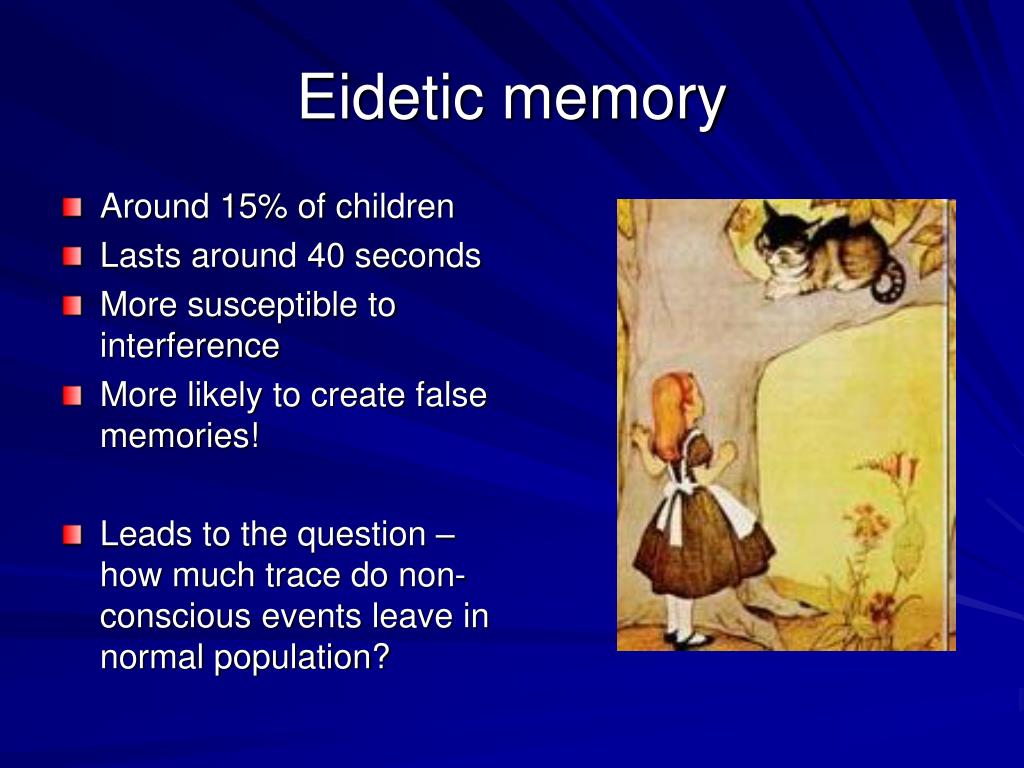
She insisted, despite these feats, that her memory had already declined somewhat.

#Photographic memory vs eidetic full
A highly intelligent 23-year-old student at Harvard University, shesaid that shecould project a beard on a beardless face and leaves on a barren tree her remembrance of things past included a passage from Goethe, read in the original German four years earlier, and a full ten-second episode from a Laurel and Hardy film. An adult friend of Stromeyer’s claimed to have remarkable eidetic abilities. Stromeyer I11 of Bell Telephone Laboratories, Murray Hill, N.J., suggestedthat even this objective test was not sufficiently stringent the children might have guessed the composite from either picture. Devising a more direct experiment, not dependent on verbal facility nor subject to memory bias, he showed two pictures in sequence to the eidetic children when the first was superimposed eidetically upon the second, it formed a third picture of a face. Conclusive proof of eidetic imagery was still lacking, Haber admitted, because his tests were not objective. No factor of sex,I.Q., age, reading achievementorpersonality differentiatedthe group from comparable non-eidetic children.

Eidetic children who named items in a picture whileactually looking at it had difficultyin formingeidetic images, indicating that such images are actually seen again rather than remembered. During a five-year period, he found only 20 children, about 4 per cent, with photographic memories. Subjects were identified as eidetic if they moved their eyes in the appropriate directions while accurately describing details of pictures previously seen for 30 seconds. (Received 10 November 1970.) strict scoring criteria, Ralph Norman Haber, Professor of Psychology at the University of Rochester, began screening 500 children from four elementary schools. Academy of Sciences, 2 East 63rd Street, New York, N.Y. 10, 0 1970, The New York Academy of Sciences. In 1964, using subjective tests but applying * From The Sciences,Vol. Few adults are eidetic but Jaensch claimed that 50 per cent of the elementary school-age children he studied were this observation has been speculatively explained by the fact that, with age, reasoning becomes more abstract and less visually concrete. Although the nature of eidetic imagery is still a mystery,objective tests have recently demonstrated that it does exist. Some researchers challenged the existence of the phenomenon and it fell out of psychological favor until the 1960s,which saw a renewed interest in the effect of images upon perceptual memory. Jaensch found a relatively high percentage of eideticsbut his results were questioned because he depended entirely on subjective reports. The first intensive, structured experiments in eidetic memory were conducted in Germany during the 1930’s by Erich Jaensch, who asked subjects to recite details about eidetic images that they projected on a blank grey screen.

MANY EIDETIC CHILDREN Positions of every word on every page in each of the twelve volumes of the Babylonian Talmud were memorized by the Shass Pollacks, Polish memory experts, according to a 1917 study. Eidetic images remain stationary during eye movements and in some cases can be summoned for days, months or even years after the original viewing. Eidetic images differ both from ordinary visual images, vague memories that lack the immediacy of present sensations and do not appear projected in space, and from after-images, which are projected in space but move with the eyes and fade quickly. ‘L‘aimable vtritk’, a painting by the Belgian surrealist Rent Magritte, resembles such an image: a transparent but textured table floats in front of a solid brick wall. From the Greek eiddtikos-pertaining to images-eidetic images are voluntary hallucinations, preserving the detailed texture and color of scenes that may appear projected in space as diaphanous, transparent objects. Printedin Great Britain PHOTOGRAPHIC MEMORY* Mort la Brecque** Christopher Isherwood’s ‘I am a camera’ can be quoted most appropriately by eidetics, rare persons who have photographic memories. In lieu of an abstract, here is a brief excerpt of the content:


 0 kommentar(er)
0 kommentar(er)
